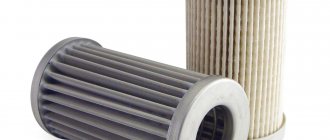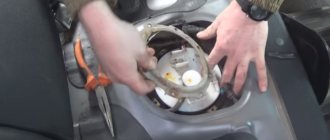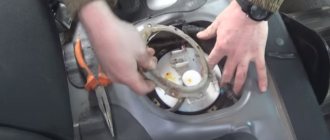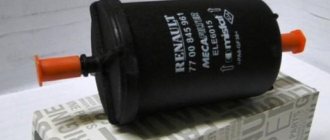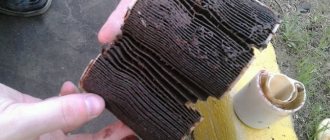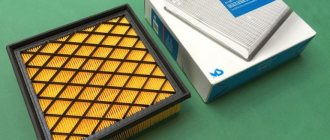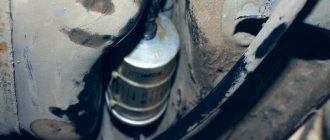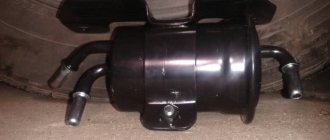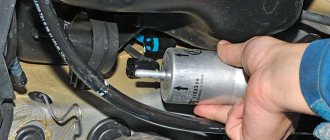Any car works due to the transformation of energy that is released during the combustion of the combustible mixture. Thanks to the vehicle's power system, fuel, as part of the combustible mixture, enters the cylinders. To ensure proper operation of this system, the fuel must be free of various impurities, as they can cause the power system to fail. Also, mechanical impurities have abrasive properties, which threatens damage to some injector components.
If the car's power system is injection, then mechanical impurities can damage or bind the precision pairs with which gasoline is dosed in the car. Their breakdown, therefore, leads to the failure of the injector. The diesel power system is most vulnerable to the presence of mechanical impurities in the fuel, since precision vapors are also present in the high-pressure fuel pump. Consequently, any vehicle power system must be equipped with fuel filters, the main purpose of which is to clean the fuel from mechanical impurities.
Types and principle of operation of fuel filters
The fuel filter circuit in modern cars has at least two degrees of fuel purification - coarse and fine. During coarse cleaning, large debris is eliminated, after which the main, fine cleaning occurs. To find out where the fuel filter is located, you need to know the features of the fuel system and car model. But, its installation, in any case, takes place between the engine and the fuel tank. In most cases, the fine fuel filter is located under the hood, in the fuel tank or under the bottom of the car. The fuel coarse filter is located directly in the tank itself.
Rules for installing filtration devices
When using a multi-stage cleaning device, the first stage is always a filter that performs rough cleaning. When using several types of systems, first install a device with high micropressure.
If you install filters of different cleaning methods in the wrong sequence, they will not be able to fully perform the task.
It is not recommended to install filter devices in front of pumping equipment. The exception is strainers with approximately zero resistance, which protect the pump from large debris.
The use of any other filters - iron removers, softeners, etc. - will increase the load on the pumping station and cause its premature wear. Installation, adjustment and repair are carried out in the absence of pressure in the water supply.
Coarse fuel filter
The fuel filter device includes a housing, inside of which there is a reflector mesh. Using a paronite gasket, this element is hermetically sealed. At the bottom of the housing there is a sediment release valve, which must be periodically cleaned, which will prevent premature clogging of the filter. Passing through a coarse filter, the fuel is cleaned of coarse impurities before it enters the highway system. In some car models, an intake reduction valve is also installed, which controls the pressure level in the fuel system.
Replacement on different types of engines
Regardless of what make and year of manufacture your car is, you will need a standard set of tools to dismantle and install the filter element:
- open-end wrenches;
- screwdriver with a thin flat blade;
- pliers;
- WD-40;
- clean fuel container;
- rags.
How to remove a filter from a carburetor engine
The procedure is made as easy as possible by the fact that the filter is installed in the engine compartment of the car. That is, it is enough to wait until the engine cools down, and then begin dismantling.
Important! Before directly removing the part, you need to relieve the pressure in the system. To do this, remove the wiring harness from the fuel pump to stop the power supply. After which the engine starts and runs until it stalls due to lack of fuel.
The order of work after releasing the pressure in the fuel system looks like this:
- Open the hood.
- The filter itself is located near the brake fluid reservoir, near the carburetor.
- Unscrew the clamps securing the two hoses.
- Remove the fuel hoses from the sides. Fuel may leak, so it is better to place a container or a rag under the holes in advance.
Disconnecting the fuel lines
Accordingly, installation of the new element is carried out in the reverse order.
How to remove the fuel filter on injection car models
The work will be somewhat more difficult than in the previous case. On injectors, the part is located under the bottom, so you will first need to either drive the car into an inspection hole or jack it up high.
In this case, the precautions will be the same as when working with carburetor engines: before dismantling, you will need to relieve the pressure in the system. Further work is carried out according to the following scheme:
- Find the fuel pump in the center of the rear beam.
- It is usually difficult to unscrew the nuts the first time, so it is recommended to lubricate the joints with WD-40 first.
- After this, unscrew the two connecting nuts and remove the fuel pipes (place containers in advance to drain the remaining fuel).
- Remove the filter along with the rubber seals from the bracket.
- After which you can install a new one in the free space.
The main thing is to create comfortable working conditions
Fine fuel filter
This element serves to completely clean the fuel from impurities before it enters the injector. In some cases, a fine fuel filter is installed in the pump itself, or in the area of the fuel line. Its main feature is that it is non-separable, therefore, repairing the fuel filter is impossible. Its replacement is carried out entirely. Inside the filter housing there is a cleaning element, which is made of porous paper. The thickness of the cleaning element is approximately 10 microns, which is the maximum value for proper operation of the injectors and pump. When larger particles get into them, failure and subsequent repairs become inevitable.
Depending on the fuel system, different fuel filters are installed on the car. This is due to the fact that each fuel system has its own design differences and features. Therefore, the following types of fuel filters are used in modern cars:
- Injection;
- Carburetor;
- Diesel.
Due to the high sensitivity of fuel equipment, fuel filters for diesel engines must be of the highest quality. Since diesel engines contain a lot of moisture, such a filter is somewhat different from a gasoline filter. In addition to purifying mechanical mixtures, filters installed in the diesel power system must also condense and remove moisture from the fuel mixture. They are also sometimes heated, since diesel fuel contains paraffins, which crystallize at low temperatures and can clog the filter element.
Features of work
Such filters require regular replacement of working elements (membranes or cartridges). The operation of the device is based on the properties of various filter materials. Most often manufacturers use:
- sorbents;
- reverse osmosis type membranes;
- ion exchange resins.
The frequency of replacement of filter elements is strictly specified in the instructions included with the product. It is determined by two factors: service life and productivity (amount of filtered water).
How to determine if the fuel filter is dirty?
A clogged fuel filter is a fairly common problem in modern cars. A clogged filter causes many problems when operating a car - it does not allow the required amount of fuel to pass through, which is necessary for the engine to operate properly. As a result, problems arise with the engine, injectors and valves. The following signs of a forgotten fuel filter can be identified:
- Significant excess fuel consumption;
- The engine does not start well;
- The power and other characteristics of the car are significantly reduced; when climbing a mountain, it accelerates very poorly;
- In some cases, the car stops on its own.
These symptoms are typical not only for cases associated with a malfunction of the fuel filter, but also occur during malfunctions of other components and systems. If the problem is not with the filter, you need to pay attention to additional signs to determine the problem. The first symptoms of a clogged fuel filter, which occur when the filter is clogged, do not seem that important. But you cannot ignore them; you should listen to all changes in engine operation and periodically replace fuel filters.
Model overview
Honeywell F76S ½ is a mainline model from a famous German brand. A mechanism for self-washing is provided. The device is equipped with a thin mesh filter. The manufacturer provides a one-year warranty for continuous use.
Unfortunately, there are often fakes on sale, the quality of which causes criticism. When purchasing, you need to make sure that you have documents with the manufacturer’s details.
Titan A380 is supplied to the market by a domestic manufacturer. A two-stage device with preliminary mechanical purification, equipped with polyfiber membranes and sorption elements. Installation of permanent flushing is possible. The product comes with a three-year warranty.
Detains all impurities, including iron. The manufacturer provides the possibility of washing the elements. For heavily polluted water, it is recommended to install a mechanical coarse filter after it.
"Cascade-duo" is an inexpensive domestic filter with two flasks. Performs mechanical and sorption cleaning. The main filter element is MAS mineral filler. Cartridges are changed once a year. Price from 4,000 rubles.
Vieir ½ is designed for fine purification of hot water. The device has a built-in pressure reducer. The brass body can withstand loads well.
Sources: sovet-ingenera.com; o-vode.net; econet.ru
How to replace the fuel filter?
To replace the fuel filter, you will need common tools such as a wrench, screwdriver, and pliers. Depending on the location of this filter, other means may also be required. If it is snap-on, you will only need pliers to remove it. If it is located on the fuel line, then it has 2 fasteners, and the fuel filter assembly is also secured with a bracket. First, before removing the filter, you need to relieve the pressure to prevent fuel spillage. This can be done by pulling out the pump fuse, after which you need to wait until the engine stalls. After you have disconnected the fuel line, remove the filter by removing it from the bracket.
After completing the above steps, you can install a new fuel filter. It is important to install it correctly; to do this, you need to look at the case where the arrows are located to determine the correct installation direction. It is recommended to remember how the previous filter was installed and install the new one as well. This will ensure correct installation. The filter must be secured to the bracket, and then the fuel line must be connected using new fasteners that come with the filter. It is also recommended to check the integrity of the fuel lines. After this, insert the pump fuse and start the engine.
Is a filter really necessary? What does it affect?
First of all, the purity of gasoline is important for the injectors of an injection engine: their thinnest holes are clogged with deposits of paraffin, sulfur, dust, dirt and other “goodies”. This is followed by deterioration in engine performance (after all, the required amount of fuel does not enter the cylinder and is not dissipated properly), loss of power, “triple”, a code in one of the cylinders when the injector fails, and then expensive repairs. For systems with a high-pressure fuel pump (HPF), cleaning is carried out before fuel enters the pump - the finishing of the parts cannot withstand foreign impurities. Buying a new pump also costs a lot of money.
How often does the fuel filter need to be changed?
Manufacturers of these components establish approximate service life. But, if low-quality fuel is used and the roads are in poor condition, replacement may be required much earlier, so it is recommended to look at the car’s mileage and the condition of the engine. replace it every 30 thousand km on diesel engines, and 60 thousand km on cars that run on gasoline. If the filter is not replaced in a timely manner, the likelihood of failure of not only the fuel equipment, but also the fuel pump, as well as the units that are responsible for starting the engine, increases. Therefore, it is very important to replace it immediately after the first signs that the filter is clogged appear.
It should be remembered that the condition of the car and its components depends on the quality of the fuel filter and its degree of clogging. In many cases, the root of problems with a car is the installation of a poor quality filter. Therefore, choose for your car only original spare parts recommended by the manufacturer.
If you have any questions, leave them in the comments below the article. We or our visitors will be happy to answer them
Which filter is better to choose?
This question is most often asked to specialists, because in most cases the car owner buys the necessary set of spare parts for maintenance.
When choosing, first of all you need to find filters that match the model and modification of the car. And it is better not to try to modernize the design of the car by installing, for example, a diesel filter on a gasoline engine.
After that, decide on the choice of brand. Everything is simple here: if you want a filter “for yourself” so that you can drive calmly and not count kilometers, choose high-quality brands of the highest category. And if you want to make the last ITV before selling, then normal budget options are also suitable.
However, most people prefer the best deals in price and quality by choosing mid-priced brands. These primarily include Bosch, which has long been loved by customers.
Inspection of the used filter
The condition of the removed filter can tell the car owner a lot:
- There is a lot of black dust in the filter pleat - the presence of manganese additives in gasoline;
- The filter is all clogged with dirt - the fuel contains a large percentage of resins and asphaltenes;
- Black mucus on the filter element – there is fungus or bacteria in the fuel;
- Wave-like curvature of the corrugated element - there is a large amount of water in the fuel.
But the condition of the outside is not as important as the type of filter inside the central channel: if there are no deposits on the inside and the paper is clean from the inside, then the filter coped with its task.
